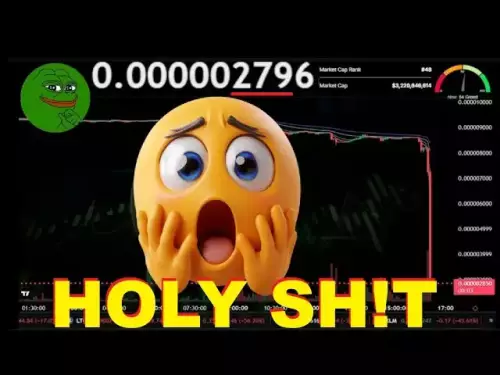-
 bitcoin
bitcoin $111375.742210 USD
-8.60% -
 ethereum
ethereum $3780.311592 USD
-13.98% -
 tether
tether $1.001299 USD
0.07% -
 bnb
bnb $1093.375857 USD
-13.01% -
 xrp
xrp $2.339375 USD
-16.91% -
 solana
solana $185.029017 USD
-16.69% -
 usd-coin
usd-coin $1.000230 USD
0.04% -
 tron
tron $0.319531 USD
-5.16% -
 dogecoin
dogecoin $0.190791 USD
-23.59% -
 cardano
cardano $0.638663 USD
-21.82% -
 ethena-usde
ethena-usde $0.998483 USD
-0.20% -
 hyperliquid
hyperliquid $37.741486 USD
-14.68% -
 chainlink
chainlink $17.229851 USD
-22.17% -
 stellar
stellar $0.316546 USD
-16.74% -
 bitcoin-cash
bitcoin-cash $507.861193 USD
-13.18%
What should I do if the volatility of FORM suddenly increases? How to adjust the trading plan?
When FORM's volatility spikes, traders should reassess risk tolerance, adjust position sizes, implement tighter stop-losses, use trailing stops, and diversify their portfolio to manage increased risk effectively.
May 03, 2025 at 03:09 am

If the volatility of FORM suddenly increases, it can be a challenging situation for traders. Adjusting your trading plan to accommodate these changes is crucial to managing risk and capitalizing on potential opportunities. In this article, we will explore the steps you can take to adjust your trading plan when the volatility of FORM increases.
Understanding Increased Volatility
Increased volatility in the cryptocurrency market, particularly with tokens like FORM, can be triggered by various factors such as market news, regulatory announcements, or significant shifts in investor sentiment. When volatility increases, the price of FORM can experience larger swings in a shorter period, which can lead to both higher potential profits and increased risk.
To manage this situation effectively, it's important to first understand the reasons behind the increased volatility. You can do this by keeping an eye on news sources, social media platforms, and market analysis reports that focus on the cryptocurrency sector, specifically FORM. By understanding the drivers of volatility, you can better anticipate potential price movements and adjust your trading strategy accordingly.
Reassessing Risk Tolerance
When volatility increases, it's essential to reassess your risk tolerance. Your risk tolerance is the amount of risk you are willing to take on in your trading activities. Higher volatility can amplify both gains and losses, so it's important to ensure that your trading plan aligns with your risk tolerance.
To reassess your risk tolerance, consider the following:
- Review your financial goals and see if they have changed since you last assessed your risk tolerance.
- Evaluate your current financial situation to determine if you can afford to take on more risk.
- Consider your emotional response to market fluctuations. If you find yourself becoming overly stressed or anxious with increased volatility, it may be a sign that your risk tolerance is lower than you initially thought.
By taking the time to reassess your risk tolerance, you can make more informed decisions about how to adjust your trading plan to better manage the increased volatility of FORM.
Adjusting Position Sizes
One of the most effective ways to manage increased volatility is to adjust your position sizes. Position sizing refers to the amount of capital you allocate to a single trade. When volatility increases, it's generally advisable to reduce your position sizes to limit potential losses.
To adjust your position sizes effectively, consider the following steps:
- Calculate your maximum risk per trade. This is typically a percentage of your total trading capital that you are willing to risk on a single trade.
- Determine the stop-loss level for your FORM trades. A stop-loss order is an order to sell a security when it reaches a certain price, designed to limit an investor's loss on a position.
- Use a position size calculator to determine the appropriate number of tokens to buy based on your maximum risk per trade and stop-loss level.
By reducing your position sizes, you can better manage the increased risk associated with higher volatility in FORM.
Implementing Tighter Stop-Losses
Another strategy to manage increased volatility is to implement tighter stop-losses. A tighter stop-loss means setting your stop-loss order closer to the entry price of your trade. This can help limit potential losses if the price of FORM moves against your position.
To implement tighter stop-losses effectively, follow these steps:
- Analyze the recent price movements of FORM to determine an appropriate stop-loss level. Consider using technical indicators such as the Average True Range (ATR) to help set your stop-loss.
- Set your stop-loss order at a level that allows for normal market fluctuations but triggers if the price moves significantly against your position.
- Monitor your trades closely and be prepared to adjust your stop-losses as needed based on market conditions.
By using tighter stop-losses, you can better protect your capital in a highly volatile market environment.
Utilizing Trailing Stops
Trailing stops are another useful tool for managing increased volatility. A trailing stop is a type of stop-loss order that moves with the price of the asset. As the price of FORM increases, the trailing stop moves up, locking in profits while still providing downside protection.
To utilize trailing stops effectively, consider the following steps:
- Determine the trailing stop percentage or fixed amount that you want to use. This will depend on your risk tolerance and the level of volatility in the market.
- Set your trailing stop order at the desired percentage or fixed amount below the current market price.
- Monitor the price of FORM and adjust your trailing stop as needed to ensure it continues to provide adequate protection.
By using trailing stops, you can take advantage of upward price movements while still managing the risk associated with increased volatility.
Diversifying Your Portfolio
Diversifying your portfolio is another important strategy to manage increased volatility. By spreading your investments across different assets, you can reduce the impact of volatility in any single asset, such as FORM.
To diversify your portfolio effectively, consider the following steps:
- Identify other cryptocurrencies that have a low correlation with FORM. This can help reduce the overall risk in your portfolio.
- Allocate a portion of your capital to these other assets based on your risk tolerance and investment goals.
- Regularly review and rebalance your portfolio to ensure it remains aligned with your risk tolerance and investment objectives.
By diversifying your portfolio, you can better manage the increased volatility of FORM and potentially improve your overall risk-adjusted returns.
Frequently Asked Questions
Q: How can I stay updated on the factors affecting FORM's volatility?A: To stay updated on the factors affecting FORM's volatility, you can follow reputable cryptocurrency news sources, join relevant social media groups and forums, and subscribe to market analysis reports that focus on FORM and the broader cryptocurrency market.
Q: What technical indicators can help me manage increased volatility in FORM?A: Several technical indicators can help you manage increased volatility in FORM, including the Average True Range (ATR), Bollinger Bands, and the Relative Strength Index (RSI). These indicators can help you assess the level of volatility and make more informed trading decisions.
Q: Can I use automated trading strategies to manage increased volatility in FORM?A: Yes, you can use automated trading strategies, such as algorithmic trading bots, to manage increased volatility in FORM. These strategies can help you execute trades more efficiently and manage risk more effectively. However, it's important to thoroughly test and monitor any automated trading strategy to ensure it aligns with your trading goals and risk tolerance.
Q: How often should I review and adjust my trading plan when volatility increases?A: When volatility increases, it's a good practice to review and adjust your trading plan more frequently. Depending on the level of volatility, you may want to review your plan daily or even multiple times a day to ensure it remains aligned with your risk tolerance and market conditions.
Disclaimer:info@kdj.com
The information provided is not trading advice. kdj.com does not assume any responsibility for any investments made based on the information provided in this article. Cryptocurrencies are highly volatile and it is highly recommended that you invest with caution after thorough research!
If you believe that the content used on this website infringes your copyright, please contact us immediately (info@kdj.com) and we will delete it promptly.
- Bittensor (TAO): Super Bullish Signals Point to Potential 2x Rally
- 2025-10-11 10:25:12
- Silver Price Correction: Navigating the Dip & Identifying Key SEO Keywords
- 2025-10-11 10:25:12
- MoonBull: The Crypto Meme Coin Promising 1000x Gains?
- 2025-10-11 10:30:01
- Crypto Payroll Revolution: Stablecoins, Altcoins, and the Future of Salary Payments
- 2025-10-11 10:30:01
- Decoding Crypto Trends: XRP's Bitcoin Dream, BlockDAG's Rise, and the PayFi Revolution
- 2025-10-11 10:30:01
- Amina Bank & Polygon: Institutional Staking with a Sweet 15% Yield
- 2025-10-11 10:30:15
Related knowledge

Practical parameter settings for a Bitcoin multi-timeframe moving average system
Sep 18,2025 at 10:54pm
Optimizing Timeframe Combinations for Bitcoin Trading1. Selecting appropriate timeframes is crucial when building a multi-timeframe moving average sys...

How can I filter out false breakouts in Dogecoin high-frequency trading?
Sep 22,2025 at 01:00am
Understanding False Breakouts in Dogecoin Trading1. A false breakout occurs when Dogecoin's price appears to move beyond a defined support or resistan...

Techniques for identifying tops and bottoms in the Bitcoin on-chain NVT model
Sep 20,2025 at 07:54pm
Understanding the NVT Model in Bitcoin Analysis1. The Network Value to Transactions (NVT) ratio is often described as the 'P/E ratio' of the cryptocur...

What does the surge in open interest in Bitcoincoin futures mean?
Sep 20,2025 at 11:18pm
Understanding the Surge in Dogecoin Futures Open Interest1. A surge in open interest within Dogecoin futures indicates a growing number of active cont...

How can I use the Ethereum USDT premium to gauge market sentiment?
Sep 18,2025 at 11:55pm
Understanding the Ethereum USDT Premium1. The Ethereum USDT premium refers to the price difference between USDT (Tether) traded on Ethereum-based plat...

What should I do if Ethereum staking yields decline?
Sep 20,2025 at 06:18am
Understanding the Causes Behind Declining Ethereum Staking Yields1. The Ethereum network transitioned to a proof-of-stake consensus mechanism with the...

Practical parameter settings for a Bitcoin multi-timeframe moving average system
Sep 18,2025 at 10:54pm
Optimizing Timeframe Combinations for Bitcoin Trading1. Selecting appropriate timeframes is crucial when building a multi-timeframe moving average sys...

How can I filter out false breakouts in Dogecoin high-frequency trading?
Sep 22,2025 at 01:00am
Understanding False Breakouts in Dogecoin Trading1. A false breakout occurs when Dogecoin's price appears to move beyond a defined support or resistan...

Techniques for identifying tops and bottoms in the Bitcoin on-chain NVT model
Sep 20,2025 at 07:54pm
Understanding the NVT Model in Bitcoin Analysis1. The Network Value to Transactions (NVT) ratio is often described as the 'P/E ratio' of the cryptocur...

What does the surge in open interest in Bitcoincoin futures mean?
Sep 20,2025 at 11:18pm
Understanding the Surge in Dogecoin Futures Open Interest1. A surge in open interest within Dogecoin futures indicates a growing number of active cont...

How can I use the Ethereum USDT premium to gauge market sentiment?
Sep 18,2025 at 11:55pm
Understanding the Ethereum USDT Premium1. The Ethereum USDT premium refers to the price difference between USDT (Tether) traded on Ethereum-based plat...

What should I do if Ethereum staking yields decline?
Sep 20,2025 at 06:18am
Understanding the Causes Behind Declining Ethereum Staking Yields1. The Ethereum network transitioned to a proof-of-stake consensus mechanism with the...
See all articles


























![Internet Computer Price Prediction [ICP Crypto Is A Hold?] Here’s Why Internet Computer Price Prediction [ICP Crypto Is A Hold?] Here’s Why](/uploads/2025/10/11/cryptocurrencies-news/videos/internet-computer-price-prediction-icp-crypto-hold/68e9ac40cf659_image_500_375.webp)















































